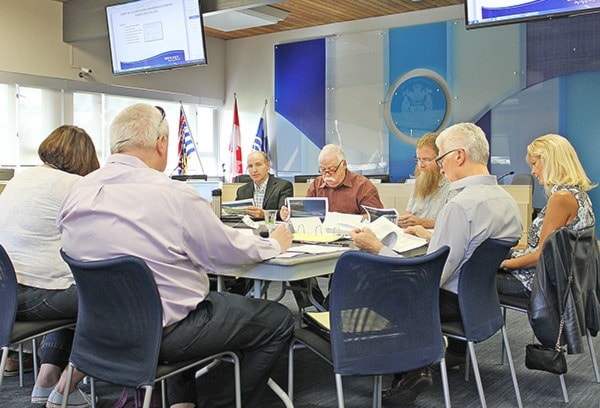Replanting of the Marine Drive hillside will get underway this fall and won’t be completed for at least three years, according to preliminary plans presented to the city’s Environmental Advisory Committee this week.
White Rock’s director of engineering and municipal operations Greg St. Louis provided committee members with a look at what city-hired consultants have recommended for the hillside, including the types of vegetation and a plan to phase-in the replanting over the next three to five years.
St. Louis told the committee – and a handful of observers, including past committee members – that the main objectives for the hillside were to eliminate invasive species and plant vegetation that is low-maintenance and economically feasible.
The hillside has been the subject of controversy since the city began work to remove trees and vegetation nearly a year ago; at the time, officials said the clearing work was being done to promote slope stability and improve lines of sight for the railway. The city later said that the vegetation needed to be removed in order to gain access to retaining walls at the top of the hillside that needed repair.
The first priority in the replanting process, St. Louis said, will be to remove blackberries from the slope over the next several months.
“We are working with (the consultants) trying to find a herbicide-free method of getting rid of the blackberries,” St. Louis said, noting the plants will have to be manually pulled from the hillside.
The recommended species of plants – described in a city report as “native” and comprising Nootka rose, salad, snowberry, oceanspray, thimbleberry and braken fern – drew some criticism from both current and former committee members.
Sharleen Hamm noted that salal – a leathery-leaved shrub from the heather family – is known to thrive in mostly shaded areas.
“This is going to be exposed, so I wonder how successful salal will be in colonizing in this area?” Hamm said.
Coun. Helen Fathers asked why no trees were included in the replanting plan, to which St. Louis responded that low-lying vegetation was purposely chosen in an effort to better the chances of gaining Burlington Northern Santa Fe approval, required before any work can move forward.
“I personally would like to have some big Douglas firs, however I know the railway would never allow that,” St. Louis said.
Darryl Walker was one of several committee members to express concerns about the difficulties of eradicating blackberries, described by St. Louis as having shallow root structures.
“I’m not sure you can stop them. Even if you pull them all out, the birds are going to bring them back,” Walker said. “Are we fighting an uphill battle here?”
Former committee member Barry Belec – who was allowed to share his thoughts following a motion passed by the committee – took issue with St. Louis’ assertion that blackberries would not promote slope stability.
“Blackberries have deep roots. They are often used to create slope stability,” Belec said. “Their roots will penetrate as deeply as six feet.”
Belec pointed out that many of the recommended plants were not native to the area, and described the suggestions as “inappropriate.”
St. Louis said feedback received at Tuesday’s meeting will be taken back to the consultants prior to a final plan being presented to council and BNSF for approval.
The committee voted unanimously to liaise with Semiahmoo First Nation and City of Surrey on what eradication and replanting efforts the two groups may be undertaking along the waterfront.
